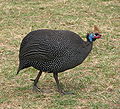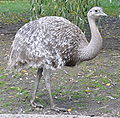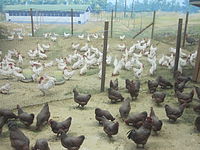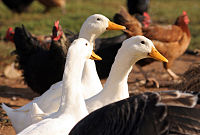- Poultry
-
Poultry exhibit at the Louisiana State Exhibit Museum in Shreveport

Poultryfood is a category of domesticated birds kept by humans for the purpose of collecting their eggs, or raising for their meat and/or feathers. These most typically are members of the superorder Galloanserae (fowl), especially the order Galliformes (which includes chickens, quails and turkeys) and the family Anatidae (in order Anseriformes), commonly known as "waterfowl" (e.g. domestic ducks and domestic geese). Poultry also includes other birds which are killed for their meat, such as pigeons or doves or birds considered to be game, like pheasants. Poultry comes from the French/Norman word, poule, itself derived from the Latin word Pullus, which means small animal.Poultry is the second most widely eaten meat in the world, accounting for about 30% of meat production worldwide, after pork at 38%.[1]
Contents
Examples
Bird Wild ancestor Domestication Utilization Picture Chicken Red Junglefowl/Grey Junglefowl Worldwide meat, feathers, eggs, ornamentation,leather 
Duck Muscovy Duck/Mallard various meat, feathers, eggs 
Emu Emu various, 20th century meat, leather, oil 
Goose Greylag Goose/Swan Goose various meat, feathers, eggs Indian peafowl Indian Peafowl various meat, feathers, ornamentation, landscaping 
Mute swan Mute Swan various feathers, eggs, landscaping 
Ostrich Ostrich various, 20th century meat, eggs, feathers, leather 
Turkey Wild Turkey Mexico meat, feathers 
Guineafowl Helmeted guineafowl Africa meat, pest consumption, and alarm calling 
Common pheasant Common pheasant Eurasia meat 
Golden pheasant Golden pheasant Eurasia meat, mainly ornamental 
Rhea Rhea various, 20th century meat, leather, oil, eggs 
Cuts of poultry
 Cuts from a plucked chicken
Cuts from a plucked chicken
 The Poultry-dealer, after Cesare Vecellio
The Poultry-dealer, after Cesare Vecellio
The meatiest parts of a bird are the flight muscles on its chest, called breast meat, and the walking muscles on the first and second segments of its legs, called the thigh and drumstick, respectively. The wings are also eaten, usually (in the United States) without separating them, as in Buffalo wings; the first and second segment of the wings are referred to as drumette (meatier) and flat when these need to be distinguished, though these are technical terms. In Japan, the wing is frequently separated, and these parts are referred to as 手羽元 (teba-moto "wing base") and 手羽先 (teba-saki "wing tip").
Dark meat, which avian myologists refer to as "red muscle," is used for sustained activity—chiefly walking, in the case of a chicken. The dark color comes from the protein myoglobin, which plays a key role in oxygen uptake within cells. White muscle, in contrast, is suitable only for short, ineffectual bursts of activity such as, for chickens, flying. Thus the chicken's leg and thigh meat are dark while its breast meat (which makes up the primary flight muscles) is white. Other birds with breast muscle more suitable for sustained flight, such as ducks and geese, have red muscle (and therefore dark meat) throughout.
Health
Consumption of large quantities of meat, including poultry, like overconsumption of any caloric food, has certain adverse effects[2] which can include: obesity, heart disease, and constipation.[3] In recent years, health concerns have been raised about the consumption of meat increasing the risk of cancer. Bird and animal fat, particularly from ruminants, tends to have a higher percentage of saturated fat vs. monounsaturated and polyunsaturated fat when compared to vegetable fats, with the exception of some tropical plant fats;[4] consumption of which has been correlated with various health problems. The saturated fat found in meat has been associated with significantly raised risks of colon cancer,[5][6] although evidence suggests that risks of prostate cancer are unrelated to animal fat consumption.[7] USDA claims (see Dietary Guidelines for Americans) that consumption of meat as a source of protein in the human diet is crucial have been resoundingly contradicted by recent studies.[8][9][10]
The correlation of meat, including poultry, consumption to increased risk of heart disease is controversial. A survey conducted in 1960 of 25,153 California Seventh-Day Adventists found that the risk of heart disease is three times greater for 45-64 year old men who eat meat daily, versus those who did not eat meat.[11] In another study[12] in 2010 involving over one million people who ate meat found that only processed meat had an adverse risk in relation to coronary heart disease. The study suggests that eating 50g (less than 2oz) of processed meat per day increases risk of coronary heart disease by 42%, and diabetes by 19%.
Chicken meat contains about two to three times as much polyunsaturated fat than most types of red meat when measured as weight percentage.[13]
A recent study by the Translational Genomics Research Institute showed that nearly half (47%) percent of the meat and poultry in U.S. grocery stores were contaminated with Staphylococcus aureus, with more than half (52%) of those bacteria resistant to antibiotics.[14]
See also
- Amenable species
- Chicken (food)
- Domestic turkey
- Duck (food)
- Oyster (fowl)
- Poultry farming
- Pollotarianism
- Roast goose
References
- ^ Raloff, Janet. Food for Thought: Global Food Trends. Science News Online. May 31, 2003.
- ^ "Shattering The Meat Myth: Humans Are Natural Vegetarians". Huffington Post. 2009-06-11. http://www.huffingtonpost.com/kathy-freston/shattering-the-meat-myth_b_214390.html. Retrieved 2010-02-21.
- ^ "// Health Issues // Optimal Vegan Nutrition". Goveg.com. http://goveg.com/essential_nutrients.asp#iron. Retrieved 2009-08-09.
- ^ "Nutrients, Vitamins, Minerals and Dietary Information". Nutristrategy.com. http://www.nutristrategy.com/nutritioninfo2.htm. Retrieved 2010-05-01.
- ^ "What You Eat May Influence Colon Cancer Relapse". American Cancer Society. 2007-08-21. Archived from the original on 2008-04-19. http://web.archive.org/web/20080419131054/http://www.cancer.org/docroot/NWS/content/NWS_1_1x_What_You_Eat_May_Influence_Colon_Cancer_Relapse.asp. Retrieved 2008-07-21.
- ^ British Journal of Cancer. "Meat consumption and risk of breast cancer in the UK Women's Cohort Study". Nature.com. http://www.nature.com/bjc/journal/v96/n7/full/6603689a.html. Retrieved 2010-05-01.
- ^ Fat and meat intake and prostate cancer risk: The multiethnic cohort study
- ^ Rejecting meat 'keeps weight low', BBC News, March 14, 2006.
- ^ Position of the American Dietetic Association and Dietitians of Canada: Vegetarian diets, Journal of the American Dietetic Association, American Dietetic Association and Dietitians of Canada, 2003, vol 103, issue 6, pp. 748–65. doi 10.1053/jada.2003.50142.
- ^ Maggie Fox, Meat raises lung cancer risk, too, study finds, Reuters, December 10, 2007; A Prospective Study of Red and Processed Meat Intake in Relation to Cancer Risk, PLoS Medicine. April 21, 2008.
- ^ Meat consumption and fatal ischemic heart disease. Prev Med. 1984] - PubMed Result
- ^ major Harvard University study
- ^ Feinberg School > Nutrition > Nutrition Fact Sheet: Lipids Northwestern University. Retrieved on August 24, 2009
- ^ US Meat and Poultry Is Widely Contaminated With Drug-Resistant Staph Bacteria
External links
- Information on Poultry Diseases
- PoultryCast podcast
- PoultryHub.org is a wiki-based collaborative resource centre where people share information about poultry
- The Poultry Guide - A to Z and FAQs
- World Poultry.net - all you need to know about poultry
- ChickenCrossing.Org - Information,discussion, links about chickens & other poultry
- Poultry.ie - Irish Poultry Community and Information Source
Wikimedia Foundation. 2010.



